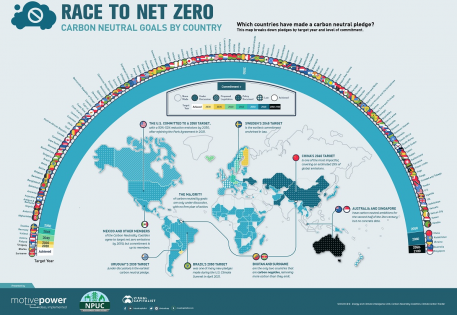PREDICTION 1: By 2050, on our current path, the world’s global carbon emissions will fall 60% short of our net zero target
With most of the international community pledging to achieve net zero carbon emissions by 2050, the pressure is on; though at our current pace, the world is falling behind. Fortunately, we still have time to turn things around.
For energy and utilities organizations, this will require a significant commitment. Encouragingly, many are stepping up. The US is targeting a carbon pollution-free power sector by 2035. In 2030, the goal is to reduce emissions by 50-52%, which would achieve net zero emissions by 2050. Some optimists predict the industry could hit net zero by 2035.
In Europe, 22 of the 25 largest power and gas utilities have set net-zero emissions targets. Some coal-powered plants in Europe and other regions have shut down operations to become clean energy leaders within renewables.
But the road ahead won’t be easy. In the US, the transition from fossil fuels to electricity generated by renewables will require the electric-power sector to simultaneously decarbonize, while supporting an increase of about 40% in electric load by as early as 2035.
| The role of technology
These ambitious targets will require large-scale infrastructure commitments, not only to achieve the end goal but to manage the transition. Organizations must move away from siloed products to platforms or a system of systems strategy that delivers real-time data for real-time results. This digitization of the operation will allow energy and utilities organizations to accurately answer two important questions: How can power be distributed in the most efficient and socio-economic way possible? How much power is required? In tandem, organizations must become good stewards of their own operations, controlling and reducing carbon emissions generated throughout their supply chain and in the field. Again, technology will play a critical role. For example, predictive maintenance and scheduling will drive operational efficiencies to help organizations achieve these goals. The world must work together to hit our target by 2050. See the Visual Capitalist chart below for carbon neutral goals by country. |

(Diagram from Visual Capitalist – Race to Net Zero: Carbon Neutral Goals by Country (June 2021)
PREDICTION 2: In 2022, investment in transmission infrastructure will increase from billions to trillions
As we saw in the first prediction, infrastructure must be modernized and strengthened to accommodate the increased electric loads for the sustainable energy goals we’ve set. This will require a complete overhaul of existing transmission facilities.
In the US, the construction of new transmission facilities will cost an estimated $314 to $504 billion. This doesn’t include the $1.8 to $2.1 trillion in new generation costs needed to hit the 2035 goal of a carbon pollution-free power sector.
To offset this, the Infrastructure Investment and Jobs Act was signed into law in the US in November 2021 and includes $1.2 trillion in spending, with an additional $550 billion subsequently added.
Europe adopted an EU-wide planning approach to transmission infrastructure, unlike the US which is managed by multiple entities. In October 2020, EU Member States agreed on a proposal to invest €998 million in critical European energy infrastructure projects.
Yet even with all of the new and increased spending, the cost versus investment will fall short. This puts more pressure on energy and utility organizations—and the people they serve—to make up the shortfall.
Additional costs for transmission infrastructure includes the undergrounding of vulnerable lines and equipment. In the US, the need to go underground takes on greater urgency due to the catastrophic wildfires caused by extreme weather events and the sparking of flames by fallen transmission lines.

Once again, there are differences between Europe and the United States. Although Europe has a much higher population, they are more densely packed so that distribution occurs over a smaller area for greater cost and resource efficiency.
| Population
(2020) |
Area
(kilometres2) |
Area
(miles2) |
Underground power lines
|
|
| Europe | 747.6 million | 10.1 million | 3.9 million | 41% |
| United States | 329.5 million | 25.3 million | 9.8 million | 18% |
The methodologies also differ, with the cost per mile roughly 30-40% lower in Europe, where utilities place insulated power lines directly in a dirt trench. US utilities place the lines inside ducts, sometimes protected by concrete. Although this makes the lines easier to maintain and repair, it’s a more expensive model, with costs ranging from $313,600 to $2.4 million per mile, and even higher in cities at $1-$5 million per mile.
| The role of technology
These whole-scale changes will transform energy and utilities infrastructure from (below) the ground up. For many organizations, even with help from governments, investors and rate payers, funding for these projects will fall short, placing a greater onus on internal efficiencies. These include better management of critical assets, optimizing field workforces, and conducting business operations quickly and accurately. According to a IDC report, technology plays an important role. With modern infrastructure in place to manage assets, field service activities, and resource planning, organizations will see an increase in productivity by at least 18%. This represents meaningful savings that can be redirected to large infrastructure projects. |
PREDICTION 3: In 2022, increased investment in digital technologies will support a better customer experience
The pandemic continues to impact how energy and utility organizations interact with their customers, with many experts predicting we will never go back to old ways.
As with most industries, customer interactions have shifted to remote and digital models, forcing utilities to increase their investment in new technologies. This has allowed utilities to expand communication channels, digitize basic services, and create more self-service options with a personalized experience.

Utilities have become leaders in the adoption of digital technologies, above the global average, with investments in Internet of Things (IoT) (65%), streaming data (56%), edge computing (54%), bottom-up Artificial Intelligence (AI) (54%), and trust-based architecture (53%).
And this is a good thing. Based on a recent survey by Forbes. post-pandemic customers are more empathetic, but also more demanding:
- 68% have seen an increase in customer expectations
- 74% have seen an increase in customer empathy
- 71% have experienced an increase in overall contact center volume
By implementing digital and cloud-based technologies, customer interactions are optimized for a faster time to resolution—and ultimately happier customers.
| The role of technology
Technology will continue to underpin how we meet and exceed the expectations of our customers, allowing us to deliver meaningful moments of service. With AR, AI, machine learning, IoT and other advances, customer interactions are enhanced. Many organizations have already implemented a modern, proactive approach to customer engagement, automating many parts of the interaction for greater efficiencies and flexibility for the customer and the business. Edge innovations are also delivering new and exciting customer engagement models. For example, merged reality allows technicians to interact remotely with customers, guiding them through troubleshooting procedures and service activities. |
Do you have questions or comments?
We’d love to hear them so please leave us a message below.
Farhat Jabeen
Great article.